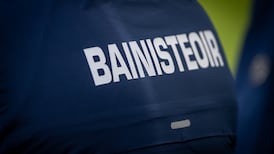If there was a news angle on Monday’s launch of the GAA’s latest strategic report, it was that wheels appear to be in motion to attempt to resolve the expenses dispute with the Gaelic Players Association.
At the unveiling of the report, ‘Aontas 2026: Towards One GAA For All,’ GAA DG Tom Ryan was asked about the proposal in the document that ‘contact hours’ for player training be regulated and whether it might be a means of finding agreement on the issue of how much time intercounty activity should be consuming for players.
His cautious response suggested it was a delicate matter.
“It might prove to be but we mightn’t go into too much detail on that this morning. Clearly where we are is not a terribly comfortable position for us or the players and the GPA but there’s enough common ground between us to be able to arrive at a resolution.
“We’ve regular interaction and meetings with the GPA and there’s one scheduled for early next week so what’s been mentioned [about contact hours] – there’s a lot of commonality there between us and there may well be grounds for resolution.”
Association president Larry McCarthy varnished it a little less: “It’s probably better to talk to each other rather than through the media.”
In overall terms the latest update on the GAA’s strategic plan, to cover the years up until 2026, was well put together and the outcome of obviously a lot of volunteered work by qualified professionals and administrators but the modern idiom for these reports is aspirational.
They tend to look for ‘more’ or ‘enhanced’ or ‘strengthened’ as opposed to hard targets. That’s probably because the report is seen as an ongoing process, which identifies key areas of concern in the specified period and leaves it to implementation to decide how it’s to be done.
Five years
It’s a continuum from the last report in 2018, which apart from its lead concern on “achieving a better balance between club and county fixtures” – fairly comprehensively addressed by the split season, currently on trial – features much of the same material, such as integration, population shifts and mitigating the impacts of intercounty involvement, strengthening communication and sustaining amateur status.
None of these issues have gone away nor is it likely that they will have by 2026. The periodic strategic reports are a way of sustaining focus on the problems.
This year is slightly different in that the report’s window has shifted from three to five years so that the plan won’t be so completely identified with a presidential term of office, according to the president Larry McCarthy.
“I think the fact that we have lengthened this timeframe to five years makes it a better strategy, because it’s not tied to one particular uachtaráin or anyone coming in. There will be an opportunity for a broader buy-in from other units in the association to feed into the national strategy.
“I think the five-year plan is better in terms of giving other units the opportunity to link in nationally and be more coherent.”
The constantly reviewed strategic plan appears to have taken the place of the once-in-a-generation blockbuster reports, such as the McNamee Commission in 1971 and three decades later, the Strategic Review Committee (2002).
It probably makes more sense from a governance point of view to keep strategy constantly under review but it also militates against radical interventions – maybe even intends to avoid the need for them.
There was also discussion of the possible reallocation of resources from commercially more successful counties to those which struggle more.
“I think it merits consideration,” said Ryan, adding with some understatement; “I think there are clearly challenges with it but there is an imperative there, some way, whatever the mechanism.”
“Spread the wealth,” interjected McCarthy, “how exactly we might do it we don’t know.”











